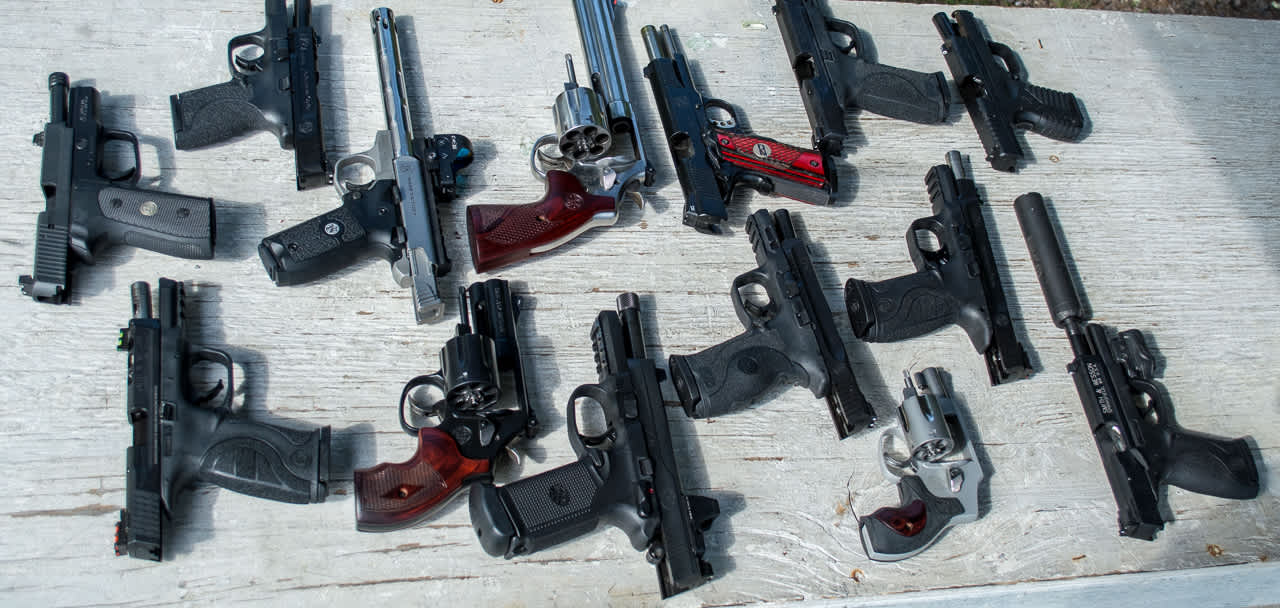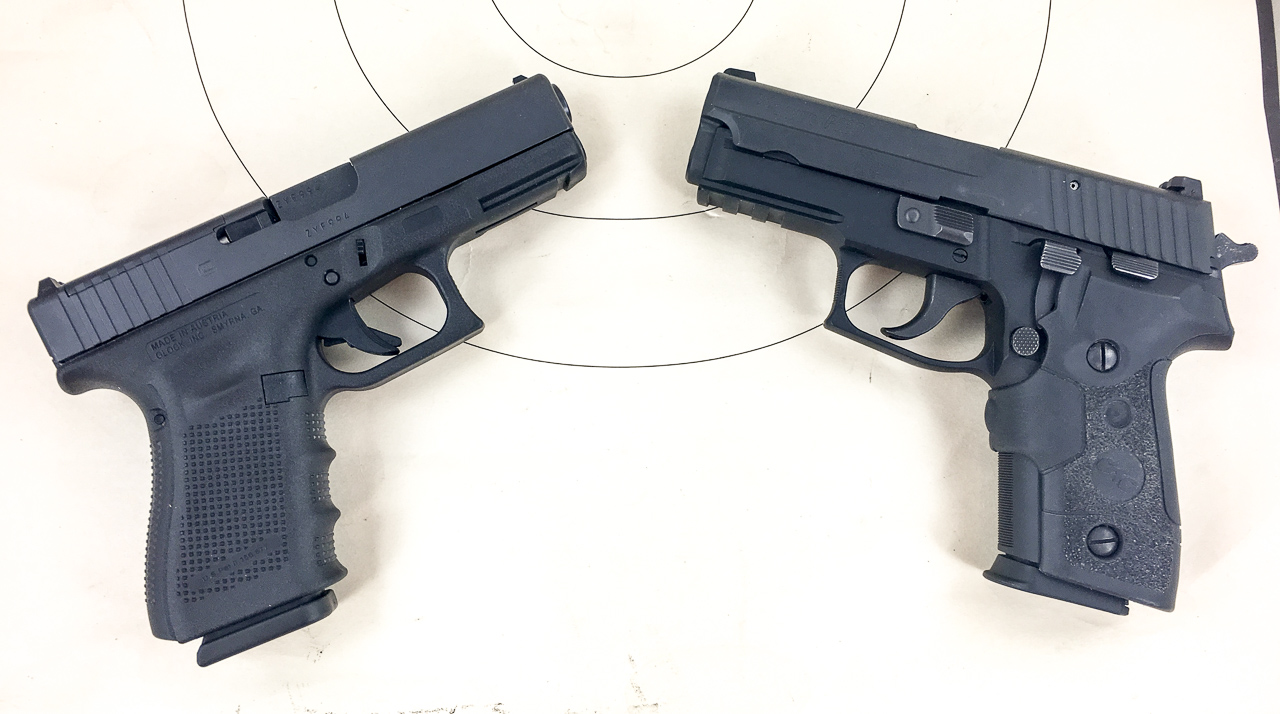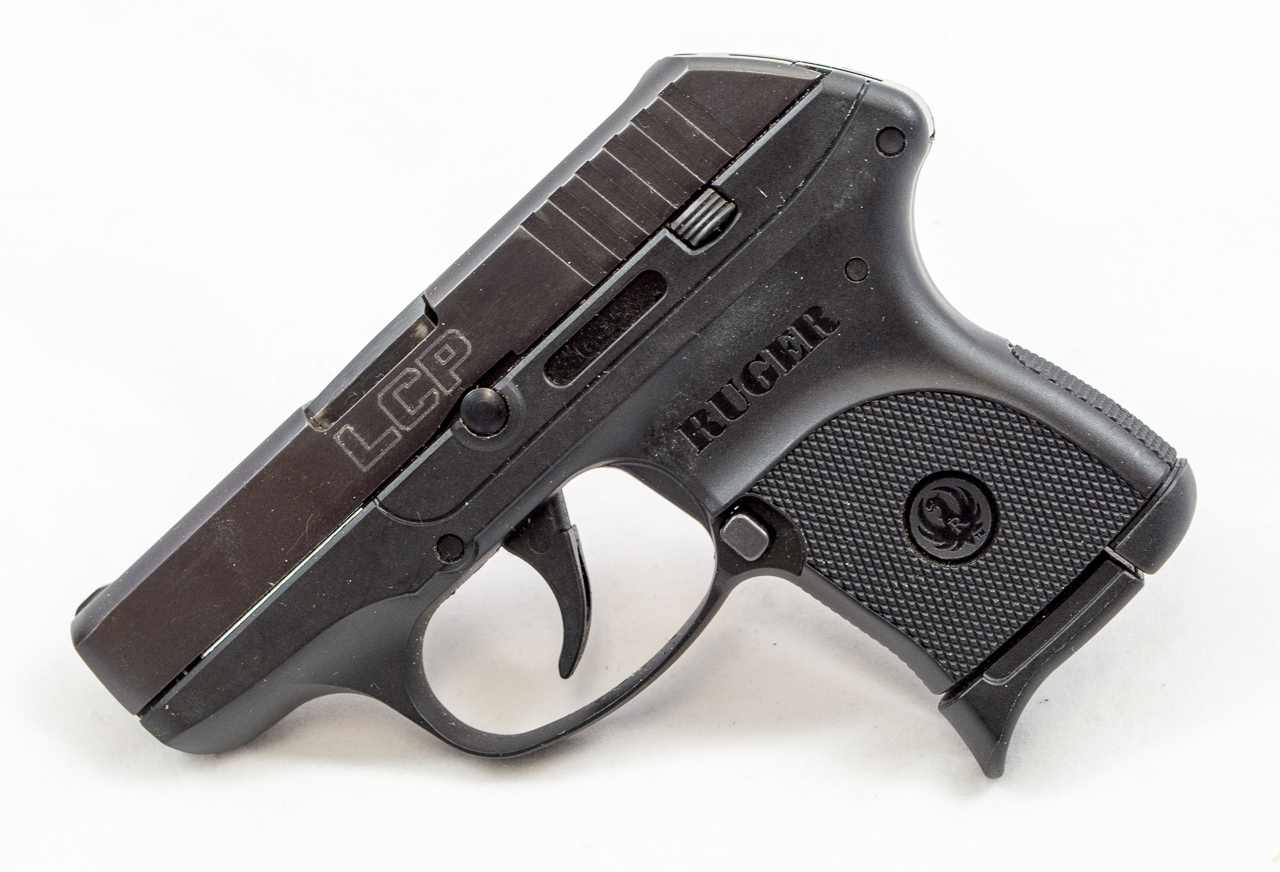When it Comes to Handguns, is Bigger REALLY Better?
Tom McHale 08.28.18

Is bigger really better? Or does it boil down to “how you use it?” When challenged by groovy son Austin about his decision to drive a Mini Cooper as his “spy car,” Nigel Powers blithely responded, “It’s not the size, mate. It’s how you use it.”
Was he right? Like psychic hotline results, the answer is whatever you want it to be. Skill usually trumps gear except when Lady Luck goes on a bender, but it’s easier to be successful when your handgun is bigger. Not a bigger caliber, but physically larger and more substantial. I admit it. I like big guns, and I cannot lie.
Why? The bottom line of effective handgun shooting is that you have to get sights on target precisely and then control the gun before, during, and after you fire it. Guess what? Larger handguns help with both fast and accurate sighting and control. Let’s explore.
Recoil by the numbers
It’s no secret that larger handguns have “less recoil” or at least feel like they do. But why is that? Let’s consider some simple math to explain precisely why.

As Uncle Isaac figure out a long time ago, every action has an equal and opposite reaction. In shooting terms, the action of stuff flying out the fiery end of a gun has to be balanced by the exactly equal action of the gun moving back towards the shooter. Not more, not less, but equal.
There are four things to consider if we’re to measure the energy of the stuff going forward. The mass of the bullet, the velocity at which it launches, the mass of the powder, and the velocity of the powder material. Yes, powder burns, but it still represents mass and motion – it’s just changing form on the fly. While the relative impact of powder versus bullet varies with every load, in rough-estimate numbers, you might expect that maybe 30% of recoil is attributed to the powder while the rest is determined by the projectile. Oh, one more quick note. For really accurate calculation, we’d want to measure the velocity of the powder separately because, by definition, it has to be moving faster than the bullet. We’ll use a fudge factor for that measurement to keep things simple. For handguns, SAAMI and others use a fudge factor of 1.5. That means that the powder mass moves one and a half times as fast as the bullet. For high-powered rifles, the fudge factor is more like 1.75.
Since we measured the “energy” of stuff going out the muzzle by mass and velocity of the components, we’ll quantify recoil the same way. The recoil force can be measured by calculating the mass of the gun and the velocity with which it moves backward. Guess what determines those? Right, the mass and velocity of the stuff flying out the muzzle.

Now that the concepts are roughly defined, we can look at some real recoil energy numbers for different handguns shooting the same ammo. Let’s start with a few different 9mm pistols just for kicks. We’ll use the same ammunition to minimize variables and show how gun weight (and velocity according to barrel length) impacts recoil energy. All numbers below are for a 9mm cartridge loaded with a 124-grain Speer Gold Dot bullet over 5.2 grains of powder. Since they’re all pistols, we’ll use the SAAMI velocity factor of 1.5 for all of them.
| Pistol | Weight (oz) | Velocity (feet per second) | Recoil Energy (foot-pounds) |
| Beretta 92 FS | 33.3 | 1,235 | 4.04 |
| Glock 26 Gen 4 | 21.5 | 1,151 | 5.43 |
| Sig Sauer P226 SAO | 34.4 | 1,223 | 3.83 |
| Glock 17 Gen 4 | 24.9 | 1,263 | 5.65 |
| Springfield Armory EMP | 27 | 1,147 | 4.29 |
| Springfield Armory XD-E | 25 | 1,150 | 4.66 |
Not surprisingly, the heaviest gun has the least amount of recoil energy. That would be the all-metal Sig Sauer P229 Elite Single Action Only pistol tipping the scales at 34.4 ounces empty. The lightest gun here, the Glock 26 Gen 4 had the second highest calculated recoil energy. Why didn’t it win? Because the Glock 17 is just ever-so-slightly heavier, but due to the longer barrel, it launches the same bullet at a faster velocity, thereby increasing recoil.
The bottom line is that all else being equal, a heavier gun will deliver less pain and movement to the shooter’s hand. That’s not only comfortable but creates a host of benefits including getting sights back on target faster and being able to fire multiple shots quickly in a controlled and accurate fashion.
Sight radius
One of the reasons that rifles are so much easier to shoot accurately than handguns is that the front and rear sights are farther apart. This measurement, called sight radius, is a big deal for repeatable precision.

To get a precise hit on target, three things need to be in perfect alignment: rear sight, front sight, and target. As the distance between any two of these increase, so does the sensitivity to misalignment. If the target is just three inches in front of the muzzle, a less than perfect alignment of front sight, rear sight, and the target will still result in a bullseye. If the target is 100 yards away, the same alignment error can result in a huge miss of several feet.
The same concept applies to any two of these factors, say the front and rear sight. Let’s look at the math to see how much sight radius affects one’s ability to shoot accurately. Let’s assume that we’re shooting at 25 yards using a pistol with a sight radius of 5.7 inches. If the sights are out of whack by .053 inches (the thickness of a dime) then you’ll miss your target by 8.4 inches. If the front and rear sight are out of alignment by just 1/32nd of an inch, then that translates to a miss of 4.9 inches on the target. If alignment is only off by the thickness of a sheet of paper, about .001 inches, that will create a miss of 0.20 inches from the point of aim.
Now let’s use a rifle at the same 25-yard distance. Let’s assume that we’re shooting an 1873 cowboy lever-action rifle with a sight radius of 17 inches. The exact same scenarios only result in misses of 2.8, 1.7, and .1 inches respectively. In other words, the farther the sights are from each other, the easier it is to be precise, and the less sensitive accuracy is to small alignment errors. In the handgun world, a full-size pistol with a 5.7-inch sight radius is a heck of a lot easier to shoot accurately than a pocket rocket with a two-inch sight radius. The reason that it’s hard to hit distant targets with a snubbie revolver isn’t that they aren’t accurate – they are. It’s because they’re harder to aim accurately. That’s a big difference.
Surface area
Big has another benefit besides the recoil-reducing ability of its weight. Big (physically) also means that there is more surface area for your hands. While pretty hard to quantify in mathematical terms, one can use any number of analogies to reflect the fact that the more surface area there is to hang on to, the easier it is to manage something.

Imagine trying to pick up a 20-pound weight that’s hanging from a thimble. Since you can only grasp the thimble with a finger and thumb, it’s going to be difficult. Now imagine the same weight suspended from a shoulder harness that wraps around your entire upper body. That’ll be easy, right? It’s an illustration of handling the same load with more surface area contact.
The same concept applies to handgun control. If a gun of the same caliber and weight can only be gripped by your thumb and one finger, it’s going to be harder to control than one that has ample grip space for all firing hand fingers, your firing hand palm and much of your support hand. Make sense?
So, before you write off big guns because they’re too bulky or too heavy, give them a real try on the range. In any given caliber, it will always be easier to shoot a larger gun well provided it’s not too physically large for your hands. You might even find that you can handle a larger caliber in that big gun with no ill effect. It’s worth a try.

